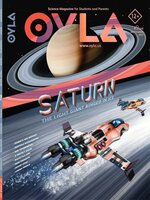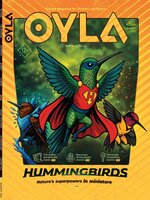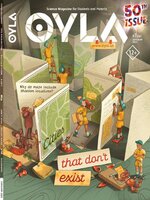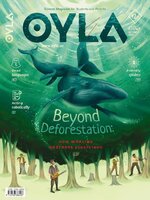OYLA Magazine is a science and technology publication for readers aged 12 and up. It features engaging articles, interactive content, and stunning visuals designed to inspire curiosity and a love for learning. Ideal for young minds eager to explore and understand the world around them.
OYLA Magazine
A Perfect Shape • Most things made by people are full of right angles. But out in nature, it’s a different story. Think about honeycombs, the compound eyes of insects, or even volcanic basalt columns-they’re all hexagon-shaped. Why does nature seem to love hexagons so much? To find the answer, we need to turn to geometry.
ACCELERATORS WITH A VAGUE FUTURE • Triumphs are rare in science, but one came in the summer of 2012. At the Large Hadron Collider, physicists discovered the long-sought Higgs boson-a cornerstone of the Standard Model of particle physics. More than a decade has now passed, and no new fundamental particles or phenomena beyond the Standard Model have been observed. Maybe it’s time to consider new tools or approaches?
HOW MANY ASTEROIDS ARE THERE IN THE ASTEROID BELT? • Many people imagine the asteroid belt as a nearly impassable barrier to spacecraft. If we look at Hollywood blockbusters like Star Wars, it does indeed seem as if only the most skilled and daring heroes can navigate through a curtain of space boulders. The reality is not nearly that dangerous, though.
10 Facts about the Human Brain • How can the same organ control your legs, allow you to enjoy music, and make you feel butterflies in your stomach all at the same time? The more we learn about the brain, the more surprising it becomes!
ROOTING OUT RUST: How to Avoid Corrosion • Metal can “get sick” too—ugly rust spots appear on its surface and gradually spread. This condition is known as corrosion, and it is relentless, leading to damaged bicycles, collapsed bridges, leaking oil pipelines, and short-circuiting wires. But where does corrosion come from, and how do people combat it?
MARKET ON THE TRACKS
MARKETS AND BAZAARS • These days, we’re so used to grabbing groceries from supermarkets or clicking “order now” online that we’ve almost forgotten what a real market feels like. Imagine the scent of fresh herbs and sweet, juicy fruit hanging in the air. Stalls packed with vibrant goods line the walkways. Everywhere you look, people are scooping, slicing, measuring, trying things on, and haggling for a better deal. When was the last time you experienced the buzz of a market like that?
HOW WE TAMED Bread • A cinnamon roll or a loaf of bread, a plate of Italian pasta or fluffy couscous, an elegant wedding cake or a humble pack of instant noodles—all these foods share one essential ingredient: wheat. Humans have been growing it for over 10,000 years. Curious how we came to “befriend” this remarkable grain? Then let’s follow the bread-crumbs of history and trace the trail of wheat through time!
WHERE HARVEST BEGINS • For about 10,000 years, people thought they knew everything about the ground beneath their feet, until soil science came along. It turns out that many factors, including climate, influence soil formation, and the soil itself is only half of them. Here’s why it’s important to study soils.
THE WHITE DESERT
Beat the Heat: A Guide to Desert Survival • Deserts have some of the harshest natural conditions on Earth. Still, people have been building cities in them for thousands of years. How do humans manage to live full lives in such a challenging environment?
THE RINGED GIANT • Every planet in the solar system has something that sets it apart. Earth is home to complex life, Mars is infamous for its planet-wide dust storms, Jupiter boasts the swirling Great Red Spot . . . and Saturn? Of course, it is instantly recognizable by its magnificent rings. Where did these rings come...

 September 2025 #58
September 2025 #58
 August 2025 #57
August 2025 #57
 July 2025 #56
July 2025 #56
 June 2025 #55
June 2025 #55
 May 2025 #54
May 2025 #54
 April 2025 #53
April 2025 #53
 March 2025 #52
March 2025 #52
 February 2025 #51
February 2025 #51
 January 2025 #50
January 2025 #50
 December 2024 #49
December 2024 #49
 November 2024 #48
November 2024 #48
 October 2024 #47
October 2024 #47
 September 2024 #46
September 2024 #46
 August 2024 #45
August 2024 #45